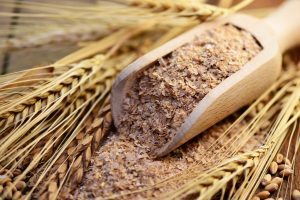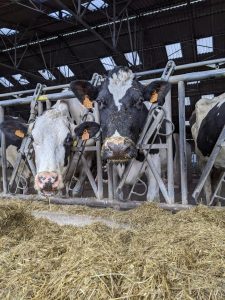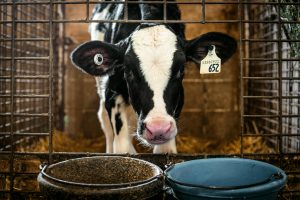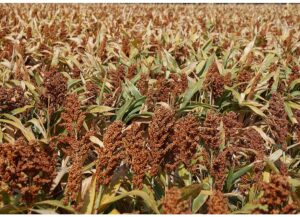Álvaro García
Mycotoxins are naturally occurring toxic compounds produced by certain molds (fungi) that can grow on crops like corn under specific environmental conditions. These compounds can pose significant risks to both human and animal health, even at low concentrations. For animal production, the presence of mycotoxins in feed can lead to health and productivity challenges, including reduced feed intake, organ damage, and immunosuppression. In livestock, mycotoxins cause a variety of health issues:
- Reduced feed intake and weight gain: Mycotoxins often make feed less palatable, resulting in reduced intake and slower weight gain, especially in poultry, swine, and young ruminants.
- Immunosuppression: Zearalenone and Ochratoxin can weaken the immune system, increasing susceptibility to infections, which raises veterinary costs and affects herd performance.
- Reproductive issues: Zearalenone’s estrogenic properties make it particularly harmful in breeding animals, particularly swine. This toxin can disrupt estrous cycles, decrease fertility, and affect fetal development.
- Organ damage: Ochratoxin, known for its nephrotoxic effects, causes kidney damage and, over time, may lead to liver damage, affecting the health and longevity of livestock.
- Neurological and respiratory problems: Fumonisin contamination can have serious health issues like equine leukoencephalomalacia (ELEM) in horses, and pulmonary edema in pigs, both of which are life-threatening.
Given these risks, continuous monitoring, and regulation of mycotoxins in corn is very important. Corn is a key feed ingredient in the U.S. and globally, making it especially vulnerable to mycotoxin contamination, particularly when storage conditions are suboptimal or during wet harvest seasons. The following sections present the findings from the U.S. Grains Council’s analysis of fumonisin, zearalenone, and ochratoxin levels in U.S. corn from 2020 to 2023, and how these findings compare to the FDA’s safety recommendations.
Sample overview
In this report, we analyzed the levels of three significant mycotoxins—fumonisin (ppm), zearalenone (ppb), and ochratoxin (ppb)—in U.S. corn samples collected over a four-year period (2020-2023). The data, provided by the U.S. Grains Council, offers a comprehensive overview of contamination levels and trends, which are critical for ensuring feed and food safety in the U.S. corn supply chain. The total number of samples were 1,253 taken over the four-year period, distributed as follows: 2020 (180 samples), 2021 (362 samples), 2022 (349 samples), and 2023: (362 samples). These samples came from various U.S. regions and the analyses for mycotoxin contamination used industry-standard methods.
Levels of mycotoxins and FDA recommendations
Fumonisin, a mycotoxin produced by Fusarium mold, is a common concern in corn. Across the four-year period, average fumonisin levels were negligible and ranged between 0.5 and 1.5 ppm. These levels are well below the FDA’s guidance level for corn intended for human consumption (2–4 ppm). For animal feed, the FDA sets different limits depending on the species: corn for swine should not exceed 5 ppm, while ruminants (e.g., beef and dairy cattle) have a higher tolerance limit of 30 ppm. The consistently low levels found in U.S. corn suggest it remained safe for both human and animal consumption throughout the study period.
Zearalenone, which can disrupt reproductive systems in livestock (especially swine), showed average levels between 25 and 60 ppb during the four-year period. The FDA does not have specific regulatory limits for zearalenone in the U.S., but an accepted safe level is below 100 ppb. The data shows that zearalenone contamination in U.S. corn remained safely within this range, with 2023 recording the lowest levels.
Ochratoxin is a potent nephrotoxin, particularly damaging to kidney health. Over the four years, average ochratoxin levels remained below 10 ppb, with samples showing even lower levels. While the FDA has not issued specific guidelines for ochratoxin in corn, the European Union sets a maximum limit of 5 ppb for human consumption and 50 ppb for animal feed. The very low levels of ochratoxin found in the U.S. corn samples indicate that this mycotoxin posed minimal risk to both human and animal health during the study period.
Correlation analysis
Through a correlation analysis we assessed the potential relationships between the presence of these mycotoxins and key grain quality parameters, including protein, starch, oil content, test weight, and broken corn and foreign material (BCFM). Interestingly, there were no significant correlations observed between each mycotoxin and these grain tests, indicating that environmental factors, rather than nutrient composition or grain physical structure, are more likely to influence contamination.
This four-year analysis of mycotoxin levels in U.S. corn demonstrated that fumonisin, zearalenone, and ochratoxin contamination remained consistently low, with all levels safely within the FDA and international safety guidelines. These findings, provided by the U.S. Grains Council, highlight the safety and quality of U.S. corn during the 2020–2023 period. While the results are reassuring, continuous monitoring remains essential to ensure feed and food safety, especially as climate and storage conditions may shift.
References
Food and Drug Administration (FDA). (2022). Guidance for Industry and FDA: Advisory Levels for Fumonisins in Animal Feed. U.S. Food & Drug Administration.
S. Grains Council. (2023). U.S. Corn Quality Report: Mycotoxin Levels in U.S. Corn Exports. U.S. Grains Council. Retrieved from https://grains.org
Zain, M. E. (2011). Impact of mycotoxins on humans and animals. Journal of Saudi Chemical Society, 15(2), 129-144.
© 2025 Dellait Knowledge Center. All Rights Reserved.









